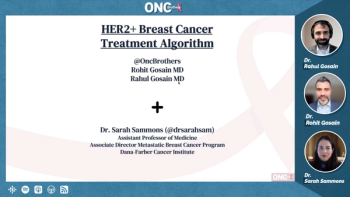
Study Identifies Cost-Effective Strategies for Neoadjuvant-Adjuvant Treatment of HER2-Positive Breast Cancer
The combination use of neoadjuvant paclitaxel, trastuzumab, and pertuzumab followed by adjuvant trastuzumab for patients with pathologic complete response or followed by adjuvant dose-dense anthracycline/cyclophosphamide plus T-DM1 for patients with residual disease offered the highest health benefits and lowest costs.
Results published in JAMA Network Open suggest that the combination of neoadjuvant paclitaxel (Abraxane), trastuzumab (Herceptin), and pertuzumab (Perjeta) followed by adjuvant trastuzumab for patients with pathologic complete response (pCR) or followed by adjuvant dose-dense anthracycline/cyclophosphamide (DDAC) plus trastuzumab emtansine (T-DM1; Kadycla) for patients with residual disease was associated with the highest health benefits and lowest costs for women with ERBB2 (HER2)-positive breast cancer compared with other treatment strategies.
“Providing patients with neoadjuvant treatment associated with decreased rates of pCR (eg [paclitaxel, trastuzumab, and pertuzumab] vs [docetaxel, carboplatin, trastuzumab, and pertuzumab]) may be associated with decreased neoadjuvant treatment costs. However, it may also be associated with increased adjuvant treatment costs due to patients with residual disease receiving more costly adjuvant treatment when they would have achieved pCR with [docetaxel, carboplatin, trastuzumab, and pertuzumab],” the authors wrote. “Our model estimates total costs associated with each neoadjuvant-adjuvant treatment strategy, accounting for neoadjuvant and adjuvant treatment costs and simulated health states.”
In this economic evaluation, a decision-analytic model was created to assess various neoadjuvant treatment strategies followed by adjuvant treatment strategies for women with ERBB2-positive breast cancer from a health care payer perspective in the US. The model utilized the KATHERINE trial, other clinical trials with different regimens from the KATHERINE trial, the Flatiron Health Database, McKesson Corporation data, and other evidence in the published literature.
Specifically, the model simulated patients receiving 5 different neoadjuvant followed by adjuvant treatment strategies. There were 4 neoadjuvant regimens, including (1) trastuzumab plus pertuzumab; (2) paclitaxel plus trastuzumab plus pertuzumab; (3) DDAC plus paclitaxel, trastuzumab, and pertuzumab; (4) and docetaxel, carboplatin, trastuzumab and pertuzumab. All patients with pCR, regardless of neoadjuvant regimen, received adjuvant trastuzumab.
Patients with residual disease received different adjuvant therapies depending on the neoadjuvant regimen according to the 5 following strategies: (1) neoadjuvant DDAC plus paclitaxel, trastuzumab, and pertuzumab followed by adjuvant trastuzumab, (2) neoadjuvant DDAC plus paclitaxel, trastuzumab, and pertuzumab followed by adjuvant T-DM1, (3) neoadjuvant paclitaxel, trastuzumab, and pertuzumab followed by adjuvant DDAC plus T-DM1, (4) neoadjuvant trastuzumab plus pertuzumab followed by adjuvant DDAC plus paclitaxel, trastuzumab, pertuzumab and T-DM1, or (5) neoadjuvant docetaxel, carboplatin, trastuzumab and pertuzumab followed by adjuvant T-DM1.
In the base-case analysis, costs ranged from $415,833 with neoadjuvant paclitaxel, trastuzumab, and pertuzumab followed by adjuvant DDAC plus T-DM1 to $518,859 neoadjuvant trastuzumab plus pertuzumab followed by adjuvant DDAC plus paclitaxel, trastuzumab, pertuzumab and T-DM1. Moreover, quality of life years (QALYs) ranged from 9.67 with neoadjuvant DDAC plus paclitaxel, trastuzumab, and pertuzumab followed by adjuvant trastuzumab to 10.73 with neoadjuvant paclitaxel, trastuzumab, and pertuzumab followed by adjuvant DDAC plus T-DM1.
Ultimately, treatment with neoadjuvant paclitaxel, trastuzumab, and pertuzumab followed by adjuvant DDAC plus T-DM1 was associated with the highest health benefits and lowest costs, dominating all other strategies. Even further, probabilistic analysis confirmed that this strategy had the highest probability of cost-effectiveness (>70% at willingness-to-pay thresholds of $0-200,000/QALY) and was associated with the highest net benefit.
“This treatment regimen seems to represent the preferred strategy in ER-positive and ER-negative cancers,” the authors wrote.
Moving forward, the investigators indicated that a clinical trial (NCT04457596) with an estimated start date of January 2021 will prospectively test de-escalation strategies using the combination of paclitaxel, trastuzumab, and pertuzumab as neoadjuvant therapy and reserving further treatment for individuals with residual disease.
Reference:
Kunst N, Wang S, Hood A, et al. Cost-Effectiveness of Neoadjuvant-Adjuvant Treatment Strategies for Women With ERBB2 (HER2)–Positive Breast Cancer. JAMA Network Open. doi: 10.1001/jamanetworkopen.2020.27074
Newsletter
Stay up to date on recent advances in the multidisciplinary approach to cancer.













































































